What Does the Acronym Dslr Stand for Brainly
DSLR cameras are the standard, most popular camera choice by far. They are versatile and offer professional photographs with high image quality. They can also work with an array of interchangeable lenses.
So what is a DSLR camera exactly? Read on to find out.
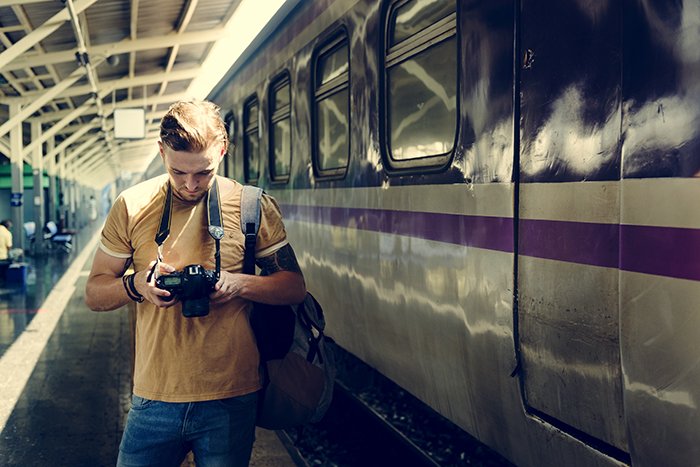
[ExpertPhotography is supported by readers. Product links on ExpertPhotography are referral links. If you use one of these and buy something we make a little bit of money. Need more info? See how it all works here.]


What Is a DSLR Camera?
First of all, what does DSLR stand for?
DSLR is the abbreviation for Digital Single Lens Reflex.
Digital means that the camera operates with a fixed, digital sensor.
Single-lens means the camera uses the same lens for framing, focusing, and taking the photograph. This is different from rangefinder and twin-lens-reflex constructions. With those types, you can't see the exact view from the lens that will take the shot. Instead, you need to rely on other methods for setting up the shot.
Reflex refers to a system where a mirror splits or directs the incoming light towards the optical viewfinder. It allows you to see an exact, optical view of the scene. This mirror can be fixed and semi-transparent (in SLT-type cameras). Or, it can flip up during exposure (in SLRs and DSLR).
So what is the difference between a DSLR and SLR camera? Mainly that the former has a digital sensor to record its images. An SLR uses film.
To learn more about photography basics, check out our Photography for Beginners course!
How Does a DSLR Work?
A DSLR system consists of two main elements: the lens and the camera body. These can be interchanged to an extent. Professionals have many lenses and often more than one camera.
Understanding their basic concept is not rocket science. It is explained best by showing the way of light:
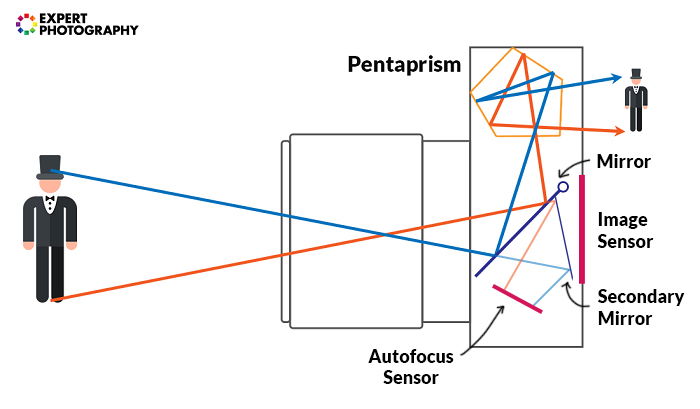
First, light hits the lens from the front. Then, it travels through the lens, which shapes it to a form the photographer desires. It then makes its way through the lens mount to the camera.
Then it encounters the main mirror. The mirror reflects most of it upwards, to the viewfinder. There, a pentaprism or a pentamirror directs it to the viewer's eye. This allows you to see exactly what the lens sees.
In SLRs and DSLRs with autofocus, a small portion of the incoming light actually passes through the main mirror. There, it hits the secondary mirror. This directs it down to the autofocusing sensor.
In this state, none of the light hits the imaging sensor. This is a key trait of DSLRs.
When you press the shutter button to take a photo, the mirrors flip up. This enables light to hit the sensor. Because the main mirror no longer reflects anything, there is a blackout in the viewfinder.
The shutter mechanism, right in front of the sensor, opens up. It exposes the image and closes down after a set amount of time. That time is called the shutter speed.
After the exposure, the moving parts go back to their previous state.
Why Do You Need a DSLR?
You might wonder, 'what is the purpose of a DSLR camera'?
First, it is a really well-tested and tried construction. SLRs have been around for a century and most people associate them with the word 'camera'.
A technical advantage of modern SLRs is that they provide a direct, optical view from the lens. So, latency or low-light noise in the viewfinder is not an issue. This is not the case with some mirrorless, bridge, and compact cameras.
Their bigger size provides space for more buttons. This allows for faster and more precise manual controls.
But they have an edge simply because of being the most wide-spread type.
You can find DSLRs ranging from entry-level devices to the highest quality medium-format models. These can easily cost you a 5-digit sum. Still, the elements are interchangeable. You could choose to mount a top professional lens on the most basic body. So, the options are plenty in every category, for every budget.
The two most popular DSLRs (Canon EF and Nikon F) have over a thousand lenses available. These include lenses manufactured by the brand or third-party manufacturers. For example, Sigma or Tamron.
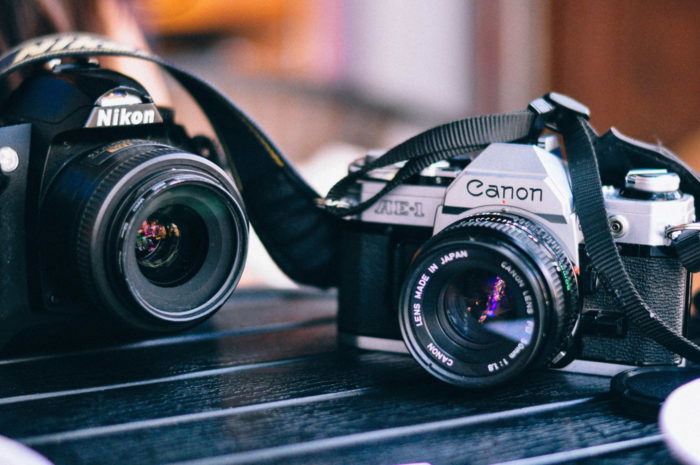
What Are the Disadvantages of DSLR Cameras?
DSLRs also have some drawbacks.
First, they are bulky, especially professional DSLRs. The rotating mirrors, the autofocusing sensor, and the complex viewfinder take up a lot of space.
The optical viewfinder also introduces problems. Its display options are very limited. For instance, you cannot see the current exposure. You can't judge if your shot will be properly exposed just by looking at an image in the optical viewfinder.
The separate autofocusing sensor can cause headaches, too. If the sensor and the image sensor are misaligned, autofocus won't work accurately. It might catch focus in front of or behind the subject you aim for.
Lastly, most of the DSLRs use mechanical shutter which means that they are rated for a certain exposure number before failing permanently.
Are There Other Options?
Mirrorless Cameras
DSLRs may one day become a thing of the past. The largest recent advancement in photographic technology is high-end mirrorless camera systems.
These are beneficial as there is no mirror action. Mirror flicking affects image stabilization, sound levels, and burst rate. Without them, we can take photographs faster and quieter. Most of them are also using electronic shutter which significantly increases their lifespan.
They are also lighter, more compact, and have many lens options. Old lenses are much easier adapted to them. They are perfect for any kind of photographic need, from street to time-lapse photography.
For more information on mirrorless cameras vs. DSLRs – read our article here.
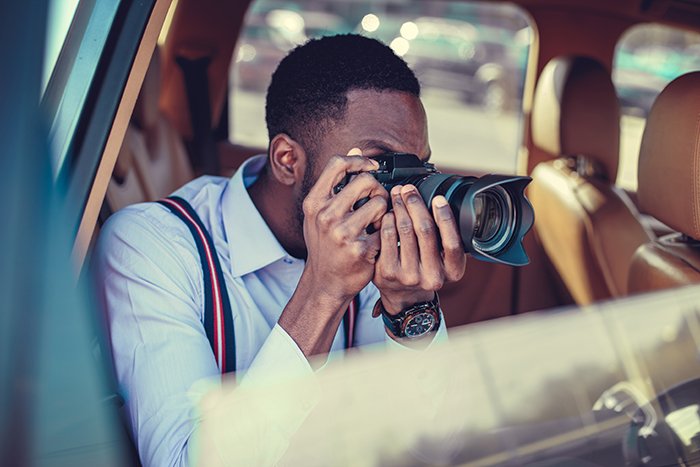 Point-and-Shoot Cameras
Point-and-Shoot Cameras
Point-and-shoot cameras are cheaper and smaller than DSLRs. A point-and-shoot system allows you to point it at something and shoot automatically.
The main benefit is in street, documentary, or travel photography. It means the camera doesn't have to be stuck to your eye.
Newer DSLRs have movable LCD screens that allow you to do this. But you still lose out on the size of your device. A small camera allows you to take better candid images than a bigger one.
DSLRs need you to master manual control of each button to bring the most out of them. A P&S is built on a different philosophy. It's ready to go from opening the packaging.
They are also much cheaper. But, some advanced models have image quality, controls, and price levels similar to mid-range DSLR cameras.
They will even shoot in RAW format, such as the Ricoh GR III.
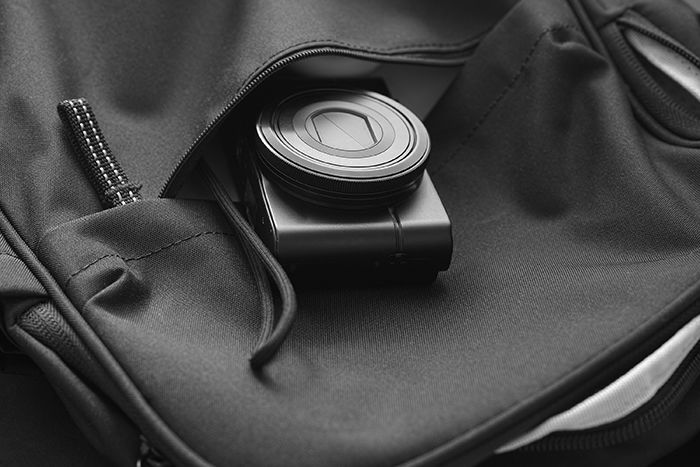
Conclusion
Whatever your budget or subject is, a DSLR is a great choice. DSLR cameras are known for their single lens, mirror system. This allows you to preview the exact optical view of the image you are about to take.
The advantage of DSLRs is that they fit into every budget. They are great for professional photographers as they allow great control.
If you want to learn more about shooting modes and autofocus, check out this article on Understanding Your First DSLR.
Do you have a new camera you've been dying to start using? Are you a little lost when it comes to settings and metering modes?
Do the words exposure compensation, f-stop and ISO setting mean nothing to you? How about white balance, low light photography, and shallow depth of field?
Check out our articles and take control of your new DSLR!
What Does the Acronym Dslr Stand for Brainly
Source: https://expertphotography.com/what-does-dslr-stand-for/